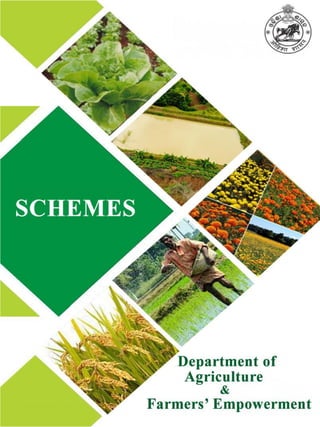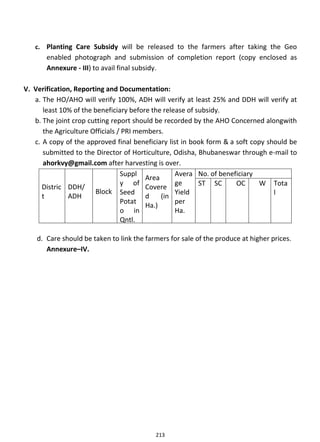This document contains information about various central and state government agricultural schemes in India. It discusses schemes related to agriculture, horticulture, soil conservation, and watershed development. Some of the key centrally sponsored schemes mentioned include the National Food Security Mission, National Mission for Sustainable Agriculture, National Mission on Agricultural Extension and Technology, and Pradhan Mantri Fasal Bima Yojana. It also lists and provides brief descriptions of various state sector schemes across these areas. The document provides details on the objectives, interventions and implementation of these different agricultural programs.


























































































































































































































































































![282
Total Unit Cost -
Financial Assistance / Subsidy to SHGs -
under the activity
Beneficiary Contribution if any -
Turn Over -
Beneficiary net income per year/
per season / activity
On an average, Rs.4615.00 per Dugwell is beingpaid towards supervision charges.
Process of release of subsidy-
1. To compensate the draw down in water table of most of the coastal areas and
supplying lifesaving irrigation to the crops in dry seasons, the Dug wells are
essential in recharging the ground water and saving the crops in dry spell. The
execution of the scheme is proposed through MGNREGS.
2. The WSHGs will be selected through Expression of Interest called by the CDPO
and shortlisted by the Block Level Selection Committee. They will mobilise unskilled
labour/members of the group in taking attendance of the unskilled labours engaged
in the proposed work and will ensure/supervise the quality of work executed.
The size of Dug wells suitable is
3.50m x8m type steining with RCC rings costing Rs. 190000/- (Approx.) out of which
the unskilled labour engagement will be for 369 man days => the person days
engagement of mate/WSHG as 12= [369/30] person days. So the payment to WSHG
is 12xRs355/- (Labour Rate for Semi Skilled Labour)=Rs. 4260.00
3.50m x8m type steining with RRHG masonry costing Rs174000/- out of which the
unskilled labour engagement will be 397 man days => the person days engagement
of mate/WSHG as 13=[397/30] person days. So the payment to WSHG is
13x355=Rs4615.00
The above figures are tentative and subject to minor charges as per actual plan and
estimate.](https://image.slidesharecdn.com/schemes-231015121741-fdfff786/85/SCHEMES-pdf-283-320.jpg)

![284
1. For management of the soil acidity and in adding natural fertility, the use of
vermi compost is essentialin such an adverse soil condition of the state .So, the
construction of vermi-compost pits is felt essential to produce vermi compost in
agriculture. The execution of the scheme is proposed through MGNREGS.
2. Where, the WSHGs will be selected through Expression of Interest called by the
CDPO and shortlisted by the Block Level Selection Committee.
3. They will mobilise unskilled labour/members of the group in taking attendance of
the unskilled labours engaged in the proposed work and will ensure/supervise
the quality of work executed.
4. The size of vermi compost pit
2x3.00m x0.75m type with brickmasonary wall construction costing Rs21000/-
out of which the unskilled labour engagement will be 26 man days => the
person days engagement of mate/WSHG as 1=[26/30] person days. So the
payment to WSHG is 1xRs355/- (Labour Rate for Semi Skilled Labour)=Rs355.00
The above figures are tentative and subject to minor changes as per actual plan and
estimate.
Supervision charges of Jute Retting Tank
Name of the Activity Supervision charges of Jute retting Tank
Name of the Scheme MGNREGS
Procedure for selection / engagement of WSHGs
under the said activity
Guidelines communicated vide letter No.20738,
dt. 27.10.2021& 24671 dt.09.12.2021 of
Department for A & FE to be followed.
Requirement of land (ha) / Space (Sq Ft) / -
Electricity ( 3-Phase or 2-Phase /
Working Capital (if Any)
Total Unit Cost -
Financial Assistance / Subsidy to SHGs -
under the activity
Beneficiary Contribution if any -](https://image.slidesharecdn.com/schemes-231015121741-fdfff786/85/SCHEMES-pdf-285-320.jpg)

![286
1. For creation of pondage in decomposing the jute plant for segregation of jute fibre
the Jute retting Tanks are essential to protect the natural water bodies from
pollution. Again the quality of indigenously produced jute fibre is not marketable;
where in the use of Jute Retting Tank will effectively enhance the quality of Jute
fibre, thus bringing in increased market value that ensures higher income to the jute
grower. So, the construction of Jute retting Tanks is felt essential to suffice the
same.
2. The execution of the scheme is proposed through MGNREGS. Where, the WSHGs
will be selected through Expression of Interest called by the CDPO and shortlisted
by the Block Level Selection Committee.
3. They will mobilise unskilled labour/members of the group in taking attendance of the
unskilled labours engaged in the proposed work and will ensure/supervise the
quality of work executed.
4. The size of Jute Retting Tank
1x 15.00m x 15.00mx 1.5m type with RCC-cum-brickmasonary wall construction
costing Rs450000/- out of which the unskilled labour engagement will be 250 man
days => the person days engagementof mate/WSHG as 8=[250/30] person days. So
the payment to WSHG is 8xRs355/- (Labour Rate for Semi Skilled
Labour)=Rs.2840.00
The above figures are tentative and subject to minor changes as per actual plan and
estimate.
Community managed Seed Center
Name of the Activity Agri-ventures by supplying farm Machineries
(Community managed Seed Center)
Name of the Scheme Odisha Millets Mission
Procedure of selection / engagement of WSHGs
under the said activity (if specific)
Requirement of Land (Ha)/ Space (Sq. ft.) /
Electricity (3-phase or 2-phase) / Working Capital
(if any then explain in details)
Guidelines communicated vide letter No.20738,
dt. 27.10.2021& 24671 dt.09.12.2021 of
Department for A & FE to be followed.
-
Total Unit Cost Rs. 1,50,000
Financial Assistance / Subsidy to WSHGs under
the activity
Beneficiary Contribution(if any
then explain in detail)](https://image.slidesharecdn.com/schemes-231015121741-fdfff786/85/SCHEMES-pdf-287-320.jpg)








